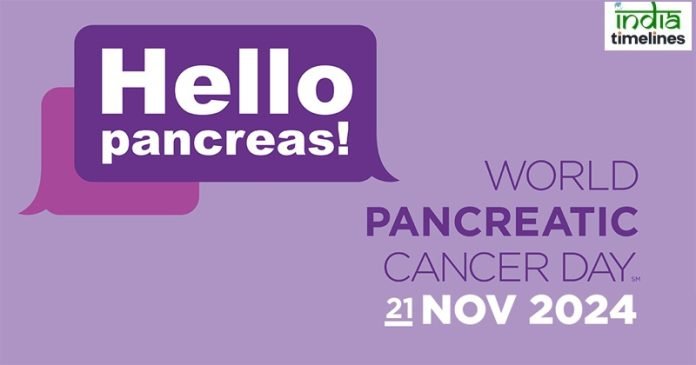
World Pancreatic Cancer Day is an important global event aimed at raising awareness about one of the deadliest forms of cancer. Every year, on the third Thursday of November, people from all over the world unite to shine a light on pancreatic cancer, its symptoms, risk factors, and the critical need for early detection and better treatments. In this article, we’ll dive deep into what pancreatic cancer is, its alarming statistics, symptoms, risk factors, treatment options, and how we can all contribute to spreading awareness and supporting the cause.
What is Pancreatic Cancer?
Pancreatic cancer occurs when abnormal cells in the pancreas grow uncontrollably, forming a tumor. The pancreas is a vital organ located behind the stomach, playing an essential role in digestion and blood sugar regulation. Unfortunately, pancreatic cancer is often diagnosed in its late stages, making it particularly lethal.
Pancreatic cancer is divided into two main types:
- Exocrine Pancreatic Cancer: This is the most common type, with tumors arising from the exocrine cells responsible for producing digestive enzymes.
- Endocrine Pancreatic Cancer: Also known as pancreatic neuroendocrine tumors (NETs), this type originates from the endocrine cells that produce hormones like insulin.
Pancreatic Cancer Statistics: A Grim Reality
Pancreatic cancer is the seventh leading cause of cancer-related deaths worldwide, and the survival rates are alarmingly low. According to the World Health Organization (WHO) and various cancer organizations, only about 10% of patients diagnosed with pancreatic cancer survive beyond five years. This low survival rate is primarily due to late-stage diagnoses when the cancer has already spread to other organs.
In 2023 alone, it is estimated that over 495,000 new cases of pancreatic cancer will be diagnosed globally, with more than 466,000 deaths attributed to the disease. These figures emphasize the urgent need for greater awareness, research funding, and improved diagnostic methods.
Recognizing the Symptoms of Pancreatic Cancer
One of the reasons pancreatic cancer is so deadly is that it often shows no symptoms in its early stages. However, as the cancer progresses, symptoms may appear, but they can be vague and easily mistaken for other conditions. Recognizing the signs is critical for early diagnosis and better outcomes.
Common symptoms of pancreatic cancer include:
- Abdominal Pain: Persistent pain in the upper abdomen that radiates to the back.
- Jaundice: Yellowing of the skin and eyes, often a sign of bile duct obstruction.
- Unexplained Weight Loss: Sudden and unexplained weight loss can be a warning sign.
- Loss of Appetite: A decreased desire to eat, even when you’re hungry.
- Fatigue: Constant tiredness and lack of energy.
- Nausea and Vomiting: Often accompanied by digestive discomfort.
It is crucial to note that these symptoms can also be associated with less severe conditions, but if they persist or worsen, it’s essential to consult a healthcare provider for further evaluation.
Risk Factors for Pancreatic Cancer
While the exact cause of pancreatic cancer is still unknown, several risk factors have been identified that can increase an individual’s likelihood of developing the disease:
- Age: Most pancreatic cancer cases occur in people over the age of 60.
- Smoking: Smokers are about twice as likely to develop pancreatic cancer compared to non-smokers.
- Obesity: Individuals who are obese have an increased risk of pancreatic cancer.
- Family History: A family history of pancreatic cancer or certain genetic conditions can elevate risk.
- Chronic Pancreatitis: Long-term inflammation of the pancreas, often due to heavy alcohol consumption, can increase the likelihood of cancer.
- Diabetes: Long-standing diabetes, especially type 2 diabetes, has been linked to pancreatic cancer.
The Importance of Early Detection
Early detection of pancreatic cancer significantly improves the chances of successful treatment. However, because the pancreas is located deep within the abdomen, early-stage tumors are often difficult to detect. This makes routine screenings challenging.
Medical advancements are underway to improve early detection, including biomarker tests and advanced imaging techniques. Until these become more widely available, being vigilant about recognizing symptoms and knowing your risk factors is key.
Current Treatment Options for Pancreatic Cancer
Treatment for pancreatic cancer depends on the stage of the disease and the patient’s overall health. The main treatment options include:
- Surgery: Surgery is the only potential cure for pancreatic cancer, but it’s only an option for about 20% of patients whose cancer is detected early. The most common surgical procedure is the Whipple procedure, which involves removing the head of the pancreas, part of the small intestine, the gallbladder, and a portion of the bile duct.
- Chemotherapy: Chemotherapy uses drugs to kill cancer cells and is often used before or after surgery to shrink tumors or reduce the risk of recurrence.
- Radiation Therapy: Radiation uses high-energy rays to target and destroy cancer cells. It may be used in combination with surgery and chemotherapy.
- Targeted Therapy: Targeted therapies are designed to specifically attack cancer cells without harming healthy cells, offering a more tailored approach to treatment.
- Immunotherapy: This innovative treatment approach aims to enhance the body’s immune system to recognize and fight cancer cells more effectively.
Supporting World Pancreatic Cancer Day: How You Can Help
World Pancreatic Cancer Day plays a critical role in educating the public and advocating for more research funding. Here’s how you can contribute to the cause:
- Raise Awareness: Use social media, blogs, and community events to spread the word about pancreatic cancer and its symptoms. The more people are aware, the higher the chance of early detection.
- Donate to Research: Supporting organizations that fund pancreatic cancer research can help accelerate the development of new treatments and early detection methods.
- Participate in Events: Many organizations host walks, runs, and other fundraising events to support pancreatic cancer awareness. Participating in these events can help raise both awareness and funds for research.
- Wear Purple: Purple is the official color of pancreatic cancer awareness. Wearing purple on World Pancreatic Cancer Day shows your support for those affected by the disease.
Conclusion
Pancreatic cancer remains one of the most challenging forms of cancer, but with increased awareness and support, we can help change the outcome for future patients. World Pancreatic Cancer Day serves as a powerful reminder of the urgent need for early detection, better treatment options, and continued research efforts. By working together, we can make strides in the fight against this devastating disease.



































